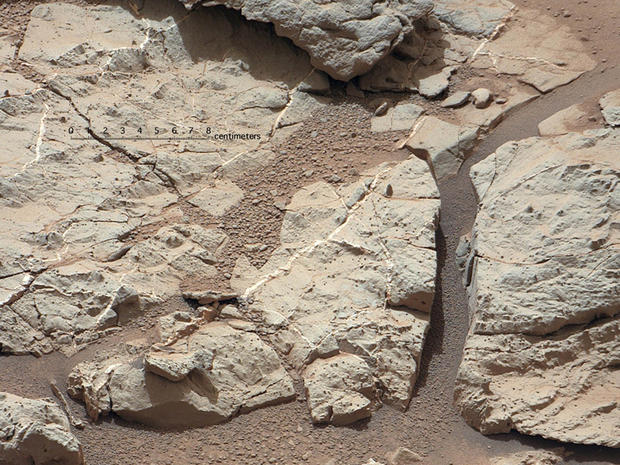Mars Rover to drill rocks that once held water
Mars Rover Curiosity will soon begin what NASA officials call "the mission's most challenging activity since the landing" as the 2-ton robot prepares to drill into Martian soil for the first time.
The Mars Science Laboratory team has identified an area of Mars with a highly diverse set of rocks as their first test bed for the untried drill. Of particular interest to the NASA team is the abundant evidence that the rocks -- located in a low-lying depression of bedrock known as Yellow Knife Bay -- once held water.
"The furthest thing we drove to is the jackpot unit," MSL project scientist John Grotzinger told reporters at a press conference on Tuesday. He went on the describe the different types of rock formations that intrigue the NASA team. Many of the rocks are cracked and feature veins of carbon sulfate. The team's belief is that the carbon sulfate most likely accumulated in the cracks because of water.
"These veins are likely composed of hydrated calcium sulfate, such as bassinite or gypsum," said ChemCam team member Nicolas Mangold of the Laboratoire de Planetologie et Geodynamique de Nantes in France. "On Earth, forming veins like these requires water circulating in fractures."
"Basically, these rocks were saturated with water," Grotzinger said.
The area of Yellowknife Bay could hold the most significant discoveries since Curiosity landed on the red planet five months ago. The diversity of rocks will keep the NASA team busy, but they will also try to determine why exactly Yellowknife Bay is so different from previous areas Curiosity has explored.
"It's like we entered a whole different world," Grotzinger said, comparing the region to Curiosity's landing spot.
"This is a great example of the occurrence of serendipity in scientific discovery." Grotzinger added, pointing out that NASA "wouldn't have predicted any of this from orbit."
NASA hopes to begin drilling sometime in the next two weeks, but cautions that it may take longer to start this difficult task.
"Drilling into a rock to collect a sample will be this mission's most challenging activity since the landing. It has never been done on Mars," said Mars Science Laboratory project manager Richard Cook of NASA's Jet Propulsion Laboratory in Pasadena, Calif. "The drill hardware interacts energetically with Martian material we don't control. We won't be surprised if some steps in the process don't go exactly as planned the first time through."

